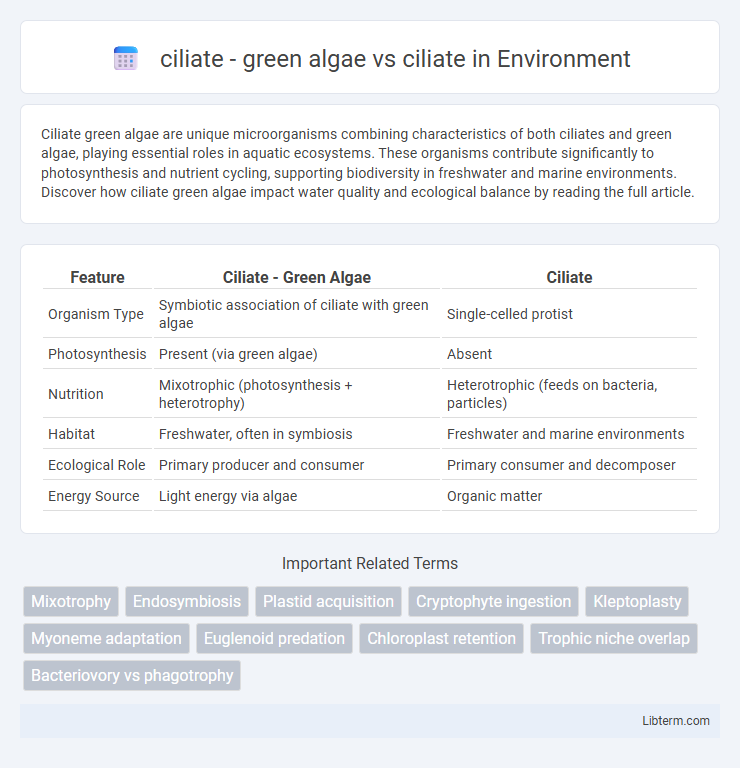Ciliate green algae are unique microorganisms combining characteristics of both ciliates and green algae, playing essential roles in aquatic ecosystems. These organisms contribute significantly to photosynthesis and nutrient cycling, supporting biodiversity in freshwater and marine environments. Discover how ciliate green algae impact water quality and ecological balance by reading the full article.
Table of Comparison
| Feature | Ciliate - Green Algae | Ciliate |
|---|---|---|
| Organism Type | Symbiotic association of ciliate with green algae | Single-celled protist |
| Photosynthesis | Present (via green algae) | Absent |
| Nutrition | Mixotrophic (photosynthesis + heterotrophy) | Heterotrophic (feeds on bacteria, particles) |
| Habitat | Freshwater, often in symbiosis | Freshwater and marine environments |
| Ecological Role | Primary producer and consumer | Primary consumer and decomposer |
| Energy Source | Light energy via algae | Organic matter |
Introduction to Ciliates and Green Algae
Ciliates are single-celled protists characterized by hair-like organelles called cilia, which facilitate movement and feeding, playing essential roles in aquatic ecosystems. Green algae, belonging to the Chlorophyta phylum, are photosynthetic organisms containing chlorophyll a and b, contributing significantly to oxygen production and serving as primary producers in freshwater and marine habitats. Unlike green algae, ciliates lack photosynthetic capabilities and depend on heterotrophic nutrition, highlighting fundamental ecological and functional differences between these two groups.
Overview of Ciliate Characteristics
Ciliates are unicellular protists characterized by the presence of hair-like organelles called cilia, which facilitate movement and feeding. Unlike green algae, which primarily rely on photosynthesis through chlorophyll pigments, ciliates obtain nutrients heterotrophically by engulfing food particles. Ciliates exhibit complex cellular structures, including dual nuclei (macro- and micronuclei), distinguishing them from the simpler organization of green algae.
Green Algae: Key Features and Diversity
Green algae, belonging to the phylum Chlorophyta, exhibit a wide range of forms including unicellular, colonial, and multicellular structures, characterized by their vibrant chlorophyll a and b pigments that enable efficient photosynthesis. They play a crucial role in aquatic ecosystems by producing oxygen and serving as a primary food source for various aquatic organisms. Their diversity spans freshwater, marine, and terrestrial habitats, with notable genera such as Chlamydomonas, Volvox, and Ulva contributing to ecological balance and biotechnological applications.
Cellular Structure: Ciliate vs Green Algae
Ciliates possess complex cellular structures with specialized organelles, including cilia for movement and dual nuclei--micronucleus and macronucleus--enabling distinct genetic functions. Green algae cells feature rigid cell walls composed mainly of cellulose and chloroplasts containing chlorophyll a and b for photosynthesis. Unlike green algae, ciliates lack cell walls and rely on pellicle layers for structural support and flexibility.
Modes of Nutrition: Autotrophy and Heterotrophy
Ciliates primarily exhibit heterotrophic nutrition by ingesting bacteria, algae, and small protozoa through phagocytosis. Green algae are predominantly autotrophic, utilizing photosynthesis via chlorophyll to convert sunlight into energy. Some ciliates can engage in mixotrophy by harboring symbiotic algae, combining both autotrophic and heterotrophic modes of nutrition.
Reproduction Methods Compared
Ciliates reproduce primarily through binary fission, asexual reproduction involving the division of a single cell into two genetically identical daughter cells, and conjugation, a sexual process exchanging genetic material without producing offspring. Green algae exhibit diverse reproductive strategies, including asexual reproduction via zoospores or fragmentation and sexual reproduction through gamete fusion in isogamous, anisogamous, or oogamous forms. The contrasting methods highlight ciliates' reliance on nuclear reorganization for genetic variation, whereas green algae employ complex life cycles involving alternation of generations and multicellular gametophytes or sporophytes.
Ecological Roles in Aquatic Ecosystems
Ciliates play a crucial role in aquatic ecosystems by regulating bacterial populations and serving as a key food source for higher trophic levels, thus maintaining microbial food web dynamics. Green algae contribute significantly to primary production through photosynthesis, producing oxygen and forming the base of aquatic food chains. Together, ciliates and green algae support nutrient cycling, energy flow, and ecosystem stability in freshwater and marine environments.
Symbiotic Relationships and Interactions
Green algae form mutualistic symbiotic relationships with ciliates, providing photosynthetically derived nutrients while benefiting from ciliates' mobility and protection. Ciliates host green algae in their cytoplasm, facilitating efficient energy exchange and enhancing survival in nutrient-poor aquatic environments. This interaction exemplifies ecological cooperation critical for sustaining freshwater and marine ecosystems.
Evolutionary Differences and Genetic Makeup
Green algae belong to the phylum Chlorophyta and possess chlorophyll a and b, enabling photosynthesis, whereas ciliates are protozoans in the phylum Ciliophora characterized by cilia used for movement and feeding. Evolutionarily, green algae diverged within the Archaeplastida supergroup, sharing a common ancestor with land plants, while ciliates evolved among the Alveolata clade, marked by complex nuclear dualism with a micronucleus and macronucleus. Genetic makeup differences include green algae having chloroplast genomes with genes for photosynthetic machinery and ciliates exhibiting nuclear dimorphism and extensive genome rearrangements unique to their ciliature and cellular organization.
Practical Applications and Scientific Importance
Green algae contribute significantly to biofuel production and wastewater treatment due to their high photosynthetic efficiency and lipid content, which enable sustainable energy solutions and environmental remediation. Ciliates play a crucial role in aquatic ecosystems as bioindicators of water quality and participate in nutrient cycling by feeding on bacteria and organic matter. Both organisms are essential in scientific research; green algae serve as model organisms for studying photosynthesis and cell biology, while ciliates provide insights into cellular processes, genetics, and protist diversity.
ciliate - green algae Infographic

 libterm.com
libterm.com